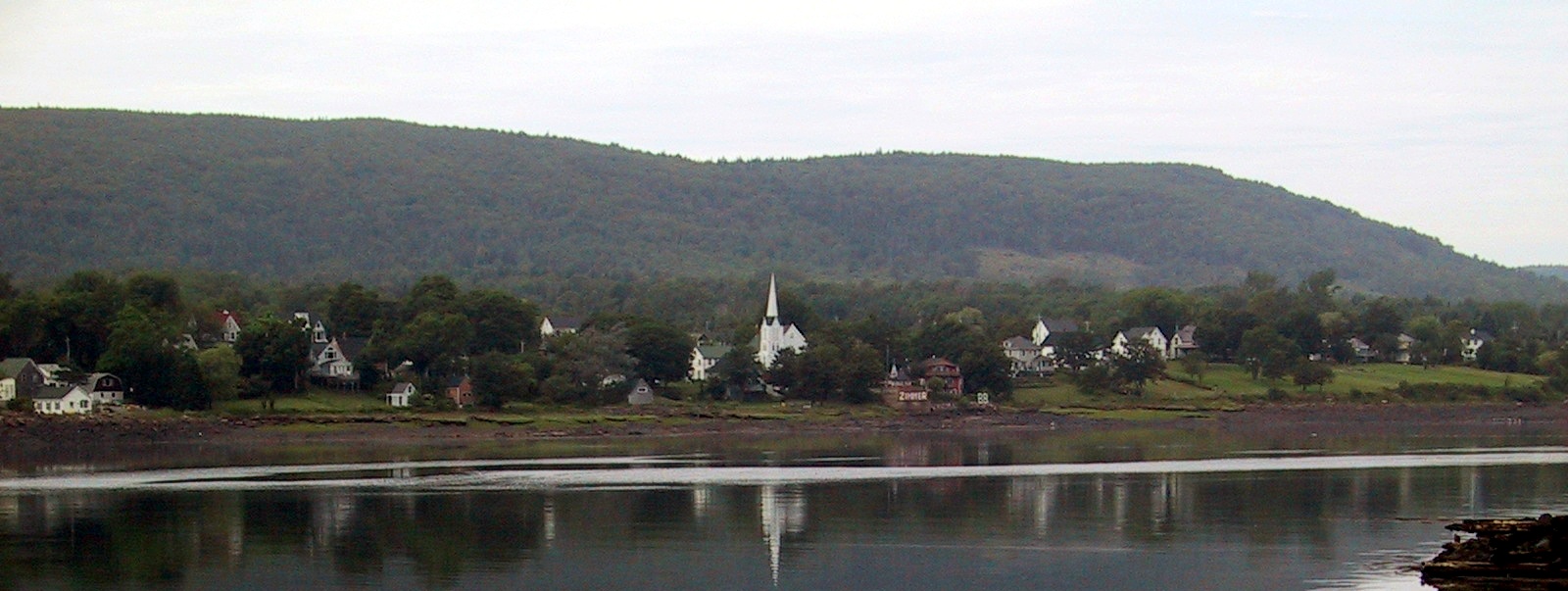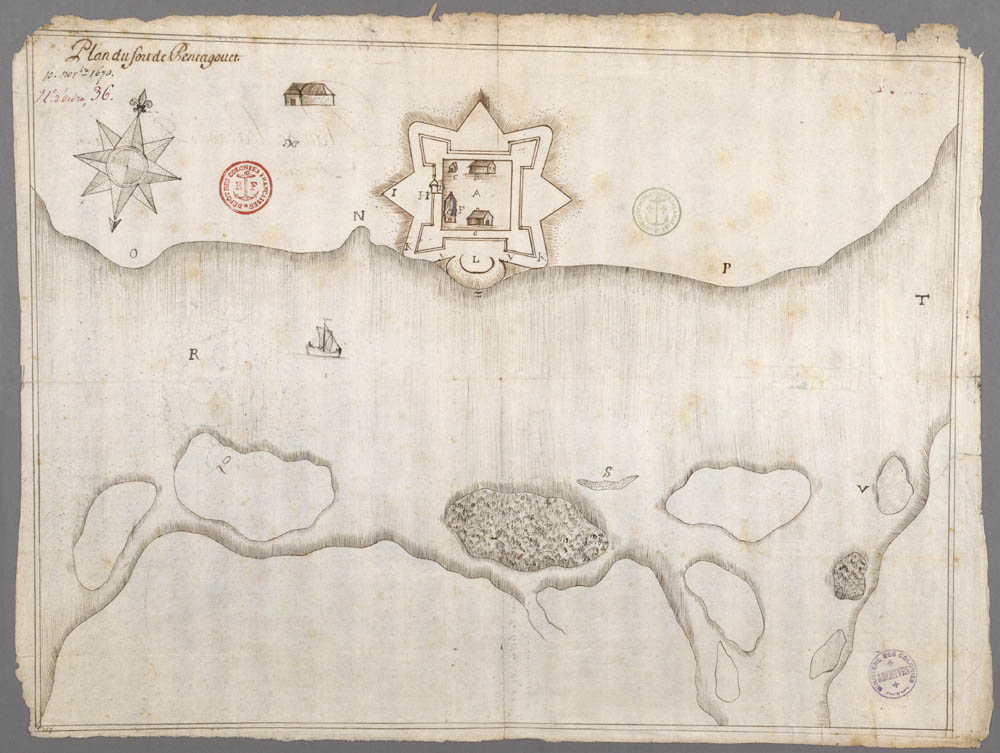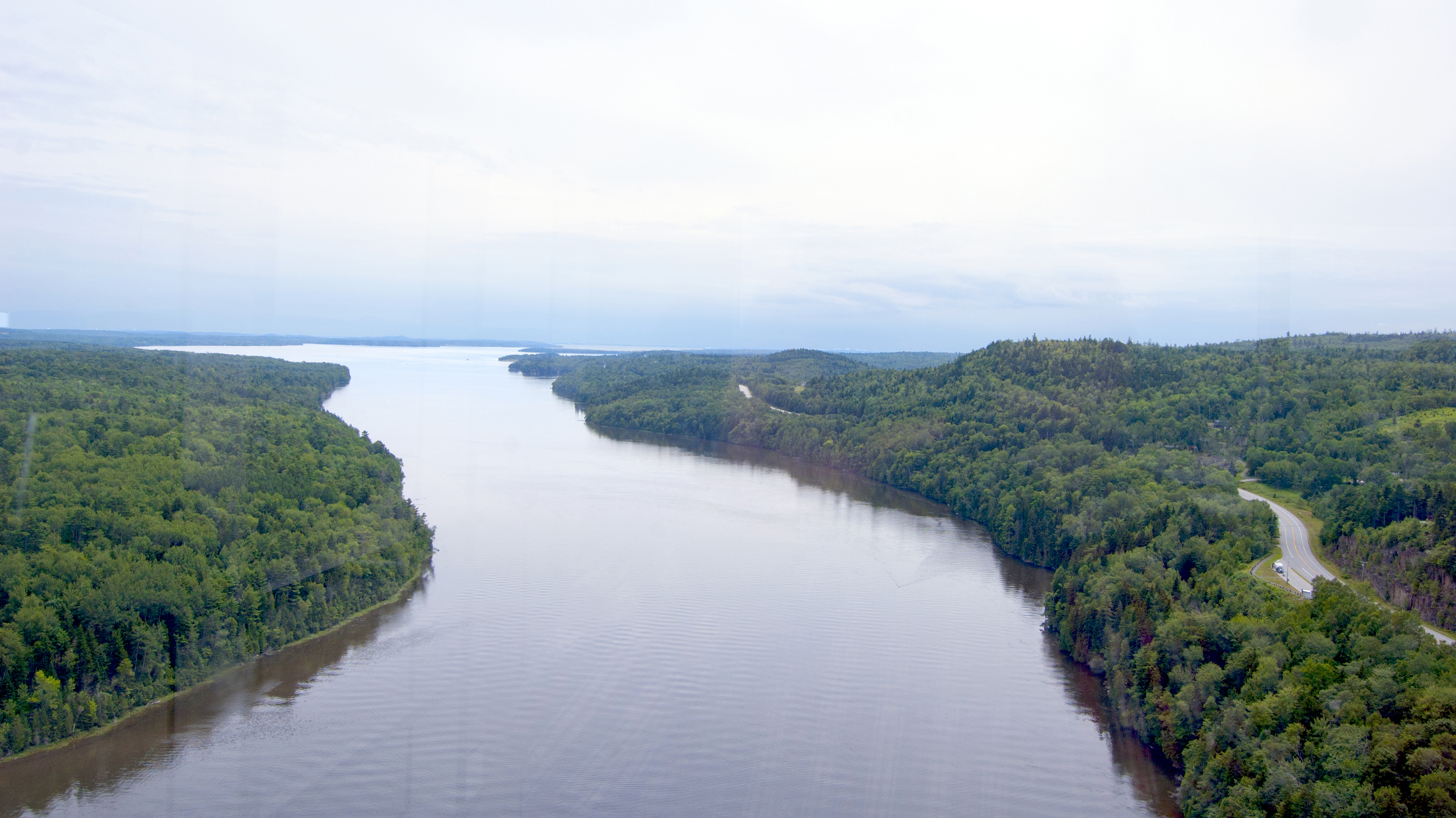|
Louis-Alexandre Des Friches De Menneval
Louis-Alexandre des Friches de Menneval ( fl. 1687–1703) was a governor of Acadia from 1687–1690. Little is known of his early life. He did serve in the French army in France with distinction and won Turenne’s notice and praise. Friches de Menneval was appointed governor of Acadia on 1 March 1687. He replaced François-Marie Perrot on the recommendation of Marquis de Chevry. At that time, he was still only a company lieutenant in the army. He was to encourage settlement and agriculture while preventing the English from trading and fishing in the Acadian jurisdiction. He was also involved in examining and investigating the activities of the former governor. Friches de Menneval did not arrive at Port-Royal until late fall and was to refurbish the fort which provided little protection against the British. He recommended that a new Fort Pentagouet be built on the Penobscot River. A variety of setbacks occurred in the next two years and no real progress was made on fortification ... [...More Info...] [...Related Items...] OR: [Wikipedia] [Google] [Baidu] |
Floruit
''Floruit'' (; abbreviated fl. or occasionally flor.; from Latin for "they flourished") denotes a date or period during which a person was known to have been alive or active. In English, the unabbreviated word may also be used as a noun indicating the time when someone flourished. Etymology and use la, flōruit is the third-person singular perfect active indicative of the Latin verb ', ' "to bloom, flower, or flourish", from the noun ', ', "flower". Broadly, the term is employed in reference to the peak of activity for a person or movement. More specifically, it often is used in genealogy and historical writing when a person's birth or death dates are unknown, but some other evidence exists that indicates when they were alive. For example, if there are wills attested by John Jones in 1204, and 1229, and a record of his marriage in 1197, a record concerning him might be written as "John Jones (fl. 1197–1229)". The term is often used in art history when dating the career ... [...More Info...] [...Related Items...] OR: [Wikipedia] [Google] [Baidu] |
Acadia
Acadia (french: link=no, Acadie) was a colony of New France in northeastern North America which included parts of what are now the Maritime provinces, the Gaspé Peninsula and Maine to the Kennebec River. During much of the 17th and early 18th centuries, Norridgewock on the Kennebec River and Castine at the end of the Penobscot River were the southernmost settlements of Acadia. The French government specified land bordering the Atlantic coast, roughly between the 40th and 46th parallels. It was eventually divided into British colonies. The population of Acadia included the various indigenous First Nations that comprised the Wabanaki Confederacy, the Acadian people and other French settlers. The first capital of Acadia was established in 1605 as Port-Royal. An English force from Virginia attacked and burned down the town in 1613, but it was later rebuilt nearby, where it remained the longest-serving capital of French Acadia until the British siege of Port Royal in 17 ... [...More Info...] [...Related Items...] OR: [Wikipedia] [Google] [Baidu] |
Henri De La Tour D'Auvergne, Vicomte De Turenne
Henri de La Tour d'Auvergne, vicomte de Turenne (11 September 161127 July 1675), commonly known as Turenne , was a French general and one of only six Marshal of France, Marshals to have been promoted Marshal General of France. The most illustrious member of the La Tour d'Auvergne family, his military exploits over his five-decade career earned him a reputation as one of the greatest military commanders in history. Born to a Huguenot family, the son of a Henri de La Tour d'Auvergne, Duke of Bouillon, Marshal of France, he was introduced to the art of war at a young age. He first served as a volunteer in the Dutch States Army under the orders of his maternal uncles Maurice of Nassau and Frederick Henry, Prince of Orange, Frederick Henry but later chose to continue his career in the service of France, where his noble origins and proven qualities soon saw him rise to the top of the military hierarchy. He rose to prominence during the Thirty Years' War by Battle of Breisach, capturi ... [...More Info...] [...Related Items...] OR: [Wikipedia] [Google] [Baidu] |
François-Marie Perrot
François-Marie Perrot (; 1644 – 1691) was born in Paris and Seigneur de Sainte-Geneviève. Biography He was appointed governor of Montreal by a royal commission in 1670 and arrived in New France that year. Records do show his tenure as 1669–84. In 1669 he married Madeleine Laguide Meynier, a niece of Jean Talon, and by her he had six children. Through Talon's influence he obtained the appointment as governor of Montreal from the seigneurs of the island, the Messieurs de Saint-Sulpice, succeeding Paul de Chomedey de Maisonneuve. On October 29, 1672, he was granted the island that now bears his name (Île Perrot Île Perrot () is an island west of the island of Montreal in the Canadian province of Quebec. Part of the Hochelaga Archipelago, the island lies between Lake Saint-Louis and Lac des Deux-Montagnes. The island was granted by the Intendant Talo ... to the west of Montreal Island) as a seignory. Perrot was the governor of Acadia from 1684–87. He was rep ... [...More Info...] [...Related Items...] OR: [Wikipedia] [Google] [Baidu] |
Annapolis Royal, Nova Scotia
Annapolis Royal, formerly known as Port Royal, is a town located in the western part of Annapolis County, Nova Scotia, Canada. Today's Annapolis Royal is the second French settlement known by the same name and should not be confused with the nearby 1605 French settlement at the Port-Royal National Historic Site also known as the Habitation. In 1629 Scottish settlers established Charles Fort at a new location, but it was ceded to France in 1632 and became the second Port-Royal. This newer French settlement was renamed in honour of Queen Anne following the siege of Port Royal in 1710 by Britain. The town was the capital of Acadia and later Nova Scotia for almost 150 years, until the founding of Halifax in 1749. It was attacked by the British six times before permanently changing hands after the siege of Port Royal in 1710. Over the next fifty years, the French and their allies made six unsuccessful military attempts to regain the capital. Including a raid during the American R ... [...More Info...] [...Related Items...] OR: [Wikipedia] [Google] [Baidu] |
Fort Pentagouet
Fort Pentagouët (Fort Pentagoet, Fort Castine, Fort Penobscot, Fort Saint-Pierre) was a French fort established in present-day Castine, Maine, which was the capital of Acadia (1670–1674). It is the oldest permanent settlement in New England. Its commanding position at the mouth of the Penobscot River estuary, a lucrative source of furs and timber, as well as a major transportation route into the interior, made the peninsula of particular interest to European powers in the 17th century. Majabagaduce (as the Abenaki name would be corrupted) changed hands numerous times with shifting imperial politics. At one time or another, it was occupied by the French, Dutch and England's Plymouth Colony. La Tour Castine was founded in the winter of 1613, when Claude de Saint-Étienne de la Tour established a small trading post to conduct business with the Tarrantine Indians (now called the Penobscots). After the trading post was established at Castine, a raid by English captain Samuel Arg ... [...More Info...] [...Related Items...] OR: [Wikipedia] [Google] [Baidu] |
Penobscot River
The Penobscot River (Abenaki: ''Pαnawάhpskewtəkʷ'') is a U.S. Geological Survey. National Hydrography Dataset high-resolution flowline dataThe National Map, accessed June 22, 2011 river in the U.S. state of Maine. Including the river's West Branch and South Branch increases the Penobscot's length to , making it the second-longest river system in Maine and the longest entirely in the state. Its drainage basin contains . It arises from four branches in several lakes in north-central Maine, which flow generally east. After the uniting of the West Branch with the East Branch at Medway (), the Penobscot flows south, past the city of Bangor, where it becomes navigable. Also at Bangor is the tributary Kenduskeag Stream. It empties into the Atlantic Ocean in Penobscot Bay. It is home to the Penobscot people that live on Indian Island, and considered to be The People's lifeblood. History Norumbega Most historians have accepted the Penobscot region as Jean Allefonsce's ... [...More Info...] [...Related Items...] OR: [Wikipedia] [Google] [Baidu] |
Louis De Buade De Frontenac
Louis de Buade, Comte de Frontenac et de Palluau (; 22 May 162228 November 1698) was a French soldier, courtier, and Governor General of New France in North America from 1672 to 1682, and again from 1689 to his death in 1698. He established a number of forts on the Great Lakes and engaged in a series of battles against the English and the Iroquois. In his first term, he supported the expansion of the fur trade, establishing Fort Frontenac (in what is now Kingston, Ontario) and came into conflict with the other members of the Sovereign Council over its expansion and over the corvées required to build the new forts. In particular, despite the opposition of bishop François de Laval, he supported selling brandy to the aboriginal tribes, which Laval considered a mortal sin. The conflict with the Sovereign Council led to his recall in 1682. His second term was characterised by the defence of Quebec from an English invasion during King William's War, a successful campaign against ... [...More Info...] [...Related Items...] OR: [Wikipedia] [Google] [Baidu] |
Governor General Of New France
Governor General of New France was the vice-regal post in New France from 1663 until 1760, and it was the last French vice-regal post. It was replaced by the British post of Governor of the Province of Quebec following the fall of New France. While the districts of Montreal and Trois-Rivières had their own governors, the governor of the district of Quebec and the Governor General of New France were the same person. The role of the Governor was to serve and represent the king in new france. List of governors general See also * Governor of Montreal * Governor of Acadia * Governor of Plaisance * Governors of French Louisiana 03 New France New France New France (french: Nouvelle-France) was the area colonized by France in North America, beginning with the exploration of the Gulf of Saint Lawrence by Jacques Cartier in 1534 and ending with the cession of New France to Great Britain and Spai ... 1663 establishments in New France 1760 disestablishments in Ne ... [...More Info...] [...Related Items...] OR: [Wikipedia] [Google] [Baidu] |
William Phips
Sir William Phips (or Phipps; February 2, 1651 – February 18, 1695) was born in Maine in the Massachusetts Bay Colony and was of humble origin, uneducated, and fatherless from a young age but rapidly advanced from shepherd boy, to shipwright, ship's captain, and treasure hunter, the first New England native to be knighted, and the first royally appointed governor of the Province of Massachusetts Bay. Phips was famous in his lifetime for recovering a large treasure from a sunken Spanish galleon but is perhaps best remembered today for establishing the court associated with the infamous Salem Witch Trials, which he grew unhappy with and forced to prematurely disband after five months. Early life Phips was born the son of James and Mary Phips, in a frontier settlement at Nequasset (present-day Woolwich, Maine), near the mouth of the Kennebec River, on February 2, 1651. His father died when the boy was six years old, and his mother married a neighbor and business partner, John White ... [...More Info...] [...Related Items...] OR: [Wikipedia] [Google] [Baidu] |
Battle Of Port Royal (1690)
The Battle of Port Royal (19 May 1690) occurred at Port Royal, the capital of Acadia, during King William's War. A large force of New England provincial militia arrived before Port Royal. The Governor of Acadia Louis-Alexandre des Friches de Menneval had only 70 soldiers; the unfinished enceinte remained open and its 18 cannon had not been brought into firing positions; 42 young men of Port-Royal were absent. Any resistance therefore appeared useless. Meneval surrendered without resistance not long after the New Englanders arrived. The New Englanders, led by Sir William Phips, after alleging Acadian violations of the terms of surrender, plundered the town and the fort. After the British sacked Pentagouet, the Wabanaki Confederacy retaliated with raids along the New England border (See Siege of Pemaquid (1689) and Raid on Salmon Falls) . These attacks were coordinated from Fort Meductic in Acadia. The merchants of Salem and Boston got up a subscription, and in the spring o ... [...More Info...] [...Related Items...] OR: [Wikipedia] [Google] [Baidu] |
Joseph Robineau De Villebon
Joseph Robineau (or Robinau) de Villebon (22 August 1655 – 5 July 1700), a governor of Acadia, was born in New France and received much of his education and military experience in France. Robinau de Villebon's importance in history occurred after his return to New France about 1681 and his deployment to Acadia in about 1685 to assist governor François-Marie Perrot and, subsequently, governor Louis-Alexandre des Friches de Meneval. It is known he was in France when William Phips captured Port Royal, Acadia in the spring of 1690. Phips took prisoners including de Meneval to Boston. Joseph Robineau re-established French rule in Acadia and was made governor there, a position he held until his death. He built the capital at Fort Nashwaak and was able to maintain the New England-Acadia boundary in present-day Maine because of his military talents and his skill in dealing with the Wabanaki Confederacy. He was involved in the Raid on Oyster River. His most significant success wa ... [...More Info...] [...Related Items...] OR: [Wikipedia] [Google] [Baidu] |







